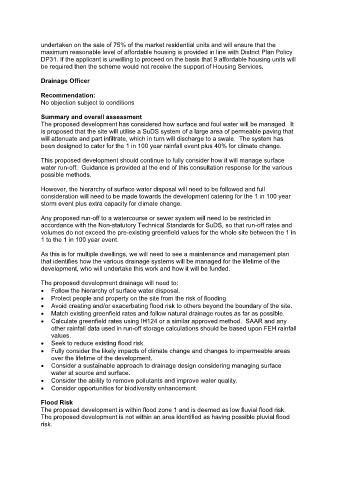Page 455 - All files for Planning Inspectorate update
P. 455
undertaken on the sale of 75% of the market residential units and will ensure that the
maximum reasonable level of affordable housing is provided in line with District Plan Policy
DP31. If the applicant is unwilling to proceed on the basis that 9 affordable housing units will
be required then the scheme would not receive the support of Housing Services.
Drainage Officer
Recommendation:
No objection subject to conditions
Summary and overall assessment
The proposed development has considered how surface and foul water will be managed. It
is proposed that the site will utilise a SuDS system of a large area of permeable paving that
will attenuate and part infiltrate, which in turn will discharge to a swale. The system has
been designed to cater for the 1 in 100 year rainfall event plus 40% for climate change.
This proposed development should continue to fully consider how it will manage surface
water run-off. Guidance is provided at the end of this consultation response for the various
possible methods.
However, the hierarchy of surface water disposal will need to be followed and full
consideration will need to be made towards the development catering for the 1 in 100 year
storm event plus extra capacity for climate change.
Any proposed run-off to a watercourse or sewer system will need to be restricted in
accordance with the Non-statutory Technical Standards for SuDS, so that run-off rates and
volumes do not exceed the pre-existing greenfield values for the whole site between the 1 in
1 to the 1 in 100 year event.
As this is for multiple dwellings, we will need to see a maintenance and management plan
that identifies how the various drainage systems will be managed for the lifetime of the
development, who will undertake this work and how it will be funded.
The proposed development drainage will need to:
Follow the hierarchy of surface water disposal.
Protect people and property on the site from the risk of flooding
Avoid creating and/or exacerbating flood risk to others beyond the boundary of the site.
Match existing greenfield rates and follow natural drainage routes as far as possible.
Calculate greenfield rates using IH124 or a similar approved method. SAAR and any
other rainfall data used in run-off storage calculations should be based upon FEH rainfall
values.
Seek to reduce existing flood risk.
Fully consider the likely impacts of climate change and changes to impermeable areas
over the lifetime of the development.
Consider a sustainable approach to drainage design considering managing surface
water at source and surface.
Consider the ability to remove pollutants and improve water quality.
Consider opportunities for biodiversity enhancement.
Flood Risk
The proposed development is within flood zone 1 and is deemed as low fluvial flood risk.
The proposed development is not within an area identified as having possible pluvial flood
risk.

